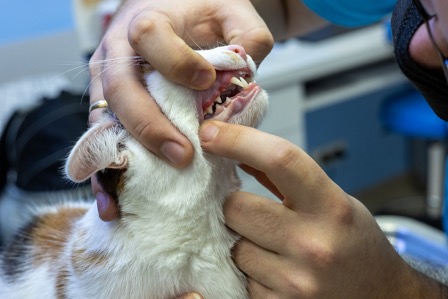A pet with poor teeth can experience pain, and they are prone to suffer serious heart, liver, and kidney problems as they age. But it can be challenging to know where to start. From brushing your pet’s teeth to regular dental checkups, this guide will cover the basics of pet teeth cleaning that you need to know.
The Importance of Professional Pet Teeth Cleaning
Periodontal disease is the most common dental condition in dogs and cats. In fact, by the time your pet is 3 years old, he or she will very likely have some early evidence of periodontal disease, which will worsen as your pet grows older if effective preventive measures aren’t taken. Early detection and treatment are critical, because advanced periodontal disease can cause severe problems and pain for your pet. Periodontal disease doesn’t just affect your pet’s mouth. Other health problems found in association with periodontal disease include kidney, liver, and heart muscle changes.
It starts with plaque that hardens into tartar. Tartar above the gumline can often easily be seen and removed, but plaque and tartar below the gumline is damaging and sets the stage for infection and damage to the jawbone and the tissues that connect the tooth to the jawbone.
The treatment of periodontal disease involves a thorough dental cleaning and x-rays may be needed to determine the severity of the disease.
Below is an example of before and after pictures of professional dental cleaning.
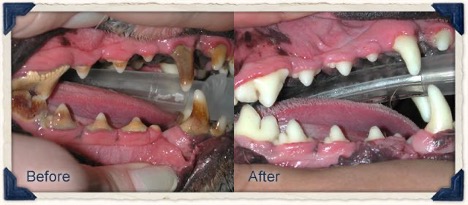
How to Properly Care for Your Pet’s Teeth at Home
While professional dental care from a veterinarian is required to remove plaque and tartar, there are some things that you can do at home to help keep your pet’s teeth and gums healthy.
- Start by brushing your pet’s teeth once daily with pet toothpaste and an appropriate brush size for their breed or size. (Never use human toothpaste for your pet).
- Additionally, you can supplement brushing with dental chews, treats, or toys to help remove plaque and tartar.
- Avoid feeding your pets human food or snacks high in sugar, which can contribute to poor oral hygiene.
- Lastly, make sure to schedule regular dental checkups with your veterinarian!
How to Clean Your Dog or Cat’s Teeth at Home
It may seem impossible at first to consider brushing your pet’s teeth. How do you get them to sit still? How do you find the time?
First, daily cleaning your pet’s teeth takes very little time. You only need to brush their teeth for 30 seconds to 1 minute. And, if you start slowly and don’t force them, many pets come to like getting their teeth brushed. Here are some at-home tips for brushing your pet’s teeth:
- Get all your supplies. You will need a pet toothbrush and pet toothpaste. You may have to experiment with different types of toothbrushes and toothpaste flavors to see which your pet likes the most and which are also easiest for you to use. Never use human toothpaste as the binding agent, and fluoride can cause a pet to have an upset stomach.
Finger brushes such as the one below made by Jasper work well for some pets, but these might be too bulky for pets with small mouths.
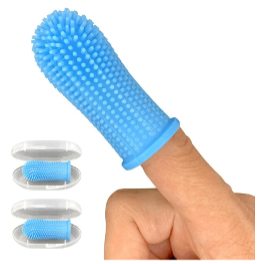
Another choice is the classic pet toothbrush, such as the one’s made by Virbac C.E.T.
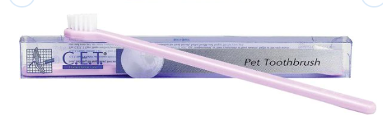
There are also 365-degree toothbrushes, such as ones made by H&H Pets. These can work well for pets that like to chew down on the toothbrush.
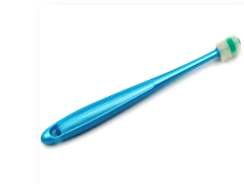
- Add “pet teeth cleaning” to your schedule. If you have a busy schedule, brushing their teeth right after their last meal makes it easy to incorporate cleaning their teeth into your schedule. And remember, you only have to spend 30 seconds to 1 minute!
- Make the experience for your pet fun and rewarding.
- First, get your pet used to the taste of the toothpaste. Let your pet smell the toothpaste and taste it. Award your pet with a treat and lots of praise so they associate the toothpaste with a good thing. Do this daily for about a week.
- When your pet is comfortable tasting the toothpaste, use your finger to rub a bit on their lips, gums, and teeth. Again, reward them with a treat and praise. Do this step for several days to a couple of weeks, depending on your pet’s tolerance.
- Next, introduce your pet to the toothbrush with toothpaste on it. Let your pet lick the toothpaste off the toothbrush. Again, take your time and use treats and praise.
- Once you have taught your pet to accept the toothbrush, start brushing in short intervals using lots of praise and treats. Work up slowly to where you can brush their teeth for 30 seconds to a minute. Focus on the outside of your pet’s teeth because the inside is less likely to have any plaque build-up. Continue to use treats and praise. Remember, if you can keep it fun for your pet, it will be easy to make it a daily routine.
- When cleaning your pet’s teeth, safety is always a priority. Ensure that your pet is in a secure and comfortable environment before you begin brushing their teeth and don’t forget to reward them for good behavior throughout the process. Avoid pulling or yanking when brushing as this can cause discomfort for your pet and make sure to use only toothpaste made specifically for pets as human toothpaste can be harmful to them.
Click on the picture below to watch the video on how to brush your pet’s teeth.
Exotic Pets
Exotic pets such as ferrets, rabbits, chinchillas, guinea pigs, rats, and reptiles have unique dental needs. So, it is important to discuss with your veterinarian, how to care for your exotic pet’s teeth and how often you need to bring them in for a dental exam. Dental disease is particularly common in pet rabbits, chinchillas, guinea pigs, and rats and can profoundly affect their overall health.
For example, guinea pigs, rabbits, rats, and chinchillas have teeth that constantly grow throughout their life. Due to improper diet or heredity, their teeth can grow incorrectly such as in the picture below of a rabbit with overgrown teeth, causing them severe pain and an inability to eat properly. With regular dental checkups, malformed teeth and dental disease can be prevented.
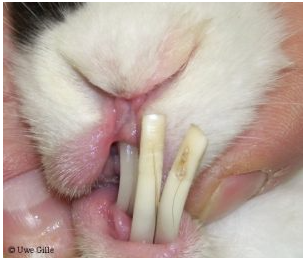
Final Words
As February is Pet Dental Month, we want to stress the importance of professional and at-home dental cleaning for your pet. We can work together to keep your pet’s teeth healthy to help them live a long and happy life. Please give us a call if you need to schedule an appointment for your pet or if you have any questions about at-home teeth cleaning.
Sincerely,
Your Friendly Team at
Hammond Veterinary Hospital

